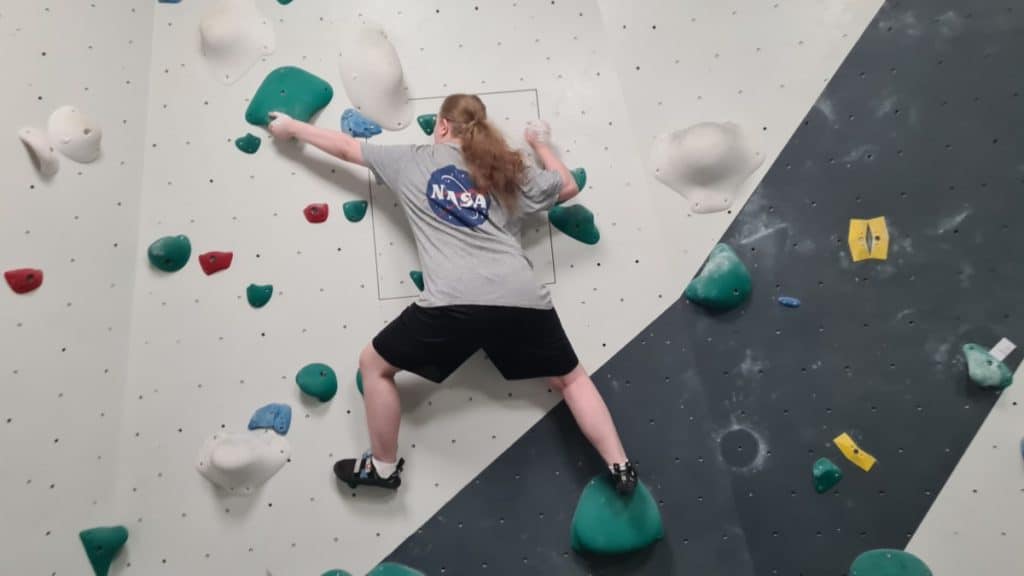
As a beginner I had no real strucuture in my climbing sessions and just climbed some random routes. As I got better and more experienced over the years, I learned a lot about structuring my climbing sessions. So how does the optimal climbing session structure look like?
As a general rule you should structure your climbing session in a way that it contains a warm-up with streches and easy climbs, a part where you try routes that are at the limit of your abilities and you will need multiple attempts and some sort of cool down where you go easy again.
Structure of a Climbing Session in General
Having a warm-up routine before you actually start climbing and try new routes is very important, because it improves your performance later as your body gets warm and prepared and you prevent injuries. When you start trying hard routes while your body is still cold the risk of injuring yourself is very high and you will also be less likely to succeed.
Because climbing is a sport where your whole body is included you will also need to warm-up every part of it. In contrast to this football athletes e.g. heavily focus on their legs and the lower part of their body when warming up. If you want to see a full streching routine for climbers click here.
There are so many different streches that all target the same body part. Because of this you can also include your own streches or subsitute some of the suggested ones. It’s just important that you get warm and strech you whole body. How you do that isn’t really important, just do the streches you personally prefer.
After streching, another part of the warm often is climbing easy routes. With climbing routes you can easily rush the first time you try them and don’t need a lot of effort you can focus on your technique and your body gets prepared for the other harder climbing routes you will climb later.
After 15-30 minutes the warm-up should be finished and the core training of your climbing session can start. You can structure this in many different ways, but always have a target you want to train for. You could structure your whole climbing session to only try hard climbing problems you couldn’t solve before.
You could also design a climbing session where you only climb techniqually hard routes and focus on your climbing technique. Another example could be a climbing session with the target of getting better at overhangs, where you focus on climbing overhangs only.
However most of your climbing session won’t be structured around something special you want to train and just be about trying hard boulder problem and improving as a climber in general. This main part of the climbing session should last about 1-2 hours depending on your climbing skill level. If you want to know how long a climbing session should be click here to learn more.
After the main part of the climbing session you should include a cool down. At this point you are pretty exhausted and already used most of your power. Try to climb a couple more easy routes to finish up your training. This helps your body to cool down slowly and will be better than abruptly stopping the climbing session.
| Part of the climbing session | Recommended duration |
| Warm-up | 15-30 minutes |
| Main part of climbing | 1-2 hours |
| Cool down | 15-30 minutes |
Climbing Session Structure for Beginner Climbers
If you are just getting started with climbing you dont really need a structure at all. Just try to include a warm up before you start climbing to prevent getting injured and then just get onto the wall and climb. Having a clear structure as a beginner isn’t necassary, because you are able to improve so much from just climbing different routes.
There are many different things to learn, so it doesn’t really matter which routes you climb. Every climbing route or boulder problem teaches you a new skill, so just look for routes you think you can climb and get going. It’s okay to try harder routes aswell as beginner, but your main focus should be on the easier ones you are able to climb.

Climbing Session Structure for Intermediate and Advanced
As a intermadite or advanced climber you already learned the fundamentals and having a structure in your climbing sessions is very benefital for your progress. Always have a target for each climbing session, something you want to work on.
This could be your foot technique or your finger strength or something else you might want to improve. Focus on this target and design the training around it. If you want to improve your grip strength only climb routes that require much finger strength that climbing session or include a hang board in your training.
Generally it is very benefitial to adress your weaknesses in your climbing sessions, as these areas are the one you can improve the most and the easiest. Try to find things you are not that good in yet and structure your climbing session in a way you can target this weakness and improve it.
If you want to know how a climbing expert structures his climbing session check out the video below. Try to take the video only as inspiration for structuring your training and don’t copy it, as it will probably not fit you.
Other Kinds of Training in a Climbing Session
There are many different things you can include in your training structure. Hangboards can be helpful if you want to focus on grip strength. Custom Climbing walls, like on the picture on the top of this article, can help you to increase you climbing endurance.
If you don’t have access to additional equipment you can also down climb every route after you finished it or climb it extra slowly in slow motion to improve your endurance, as your body stays longer under tenion and needs more power.
Final Thoughts
Having a structure in your climbing session can be very benefitial to improve on special skills, like grip strength. However most climbers that are just getting started really don’t need a special structure and should just have fun climbing.
After all most climbers are just hobby athletes and the fun is more important than improving the fastest way possible most of the times. Try to include some form of structure in your training if you are advanced in climbing, but still try to give yourself some kind of freedom and fun at climbing.
